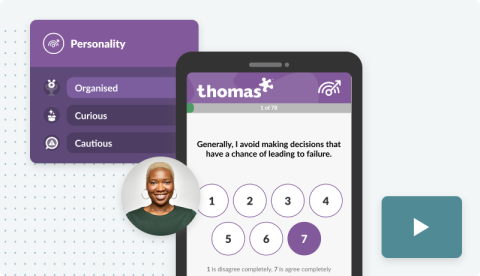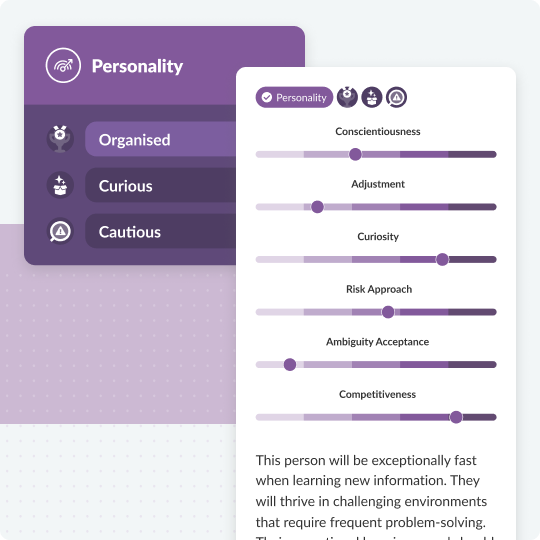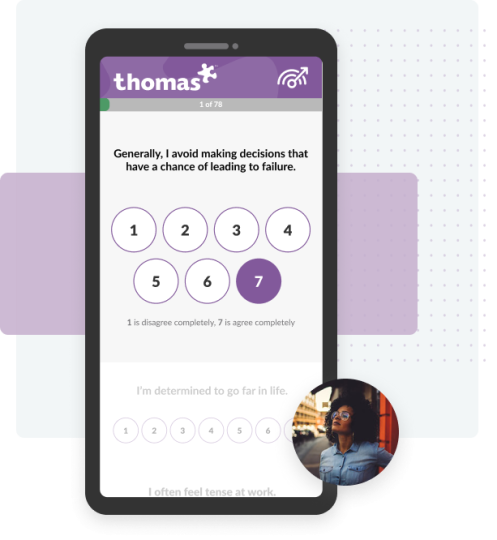High Potential Trait Indicator (HPTI)
Predict workplace success
- Get insight into strengths & weaknesses
- Improve interactions between individuals
- Understand your peoples’ resilience
- Increase manager & leader effectiveness
- Better support wellbeing
- Build more cohesive teams


What our happy customers say
The Thomas High Potential Trait Indicator (HPTI)
Our HPTI gives you the people insights to make smarter recruitment decisions, protect employee wellbeing and improve business performance.

How the High Potential Trait Indicator (HPTI) works
We present widely accepted psychological theories in our user-friendly platform, which gives you insights to make effective recruitment and development decisions.
Simple assessment
Gain comprehensive insights into a candidate's suitability to a role in ten minutes.
Detailed insight
Our insights show how each candidate responds to stress, competitiveness and openness to change at work.
Robust science
Our assessment has been extensively validated and optimized for workplace application following psychometric research with thousands of participants and is based on the Big Five psychological theory.

Assessment Information
- Assessment type: Personality
- Format: 78 questions
- Time to complete: 10 minutes
- Training required: None
Validation:
Our assessment has been extensively validated and optimized for workplace application following psychometric research with thousands of participants. This means our platform is built from science you can trust.
Read a sample candidate profile to see Thomas in action

For our senior team members, who are highly skilled and experienced people, HPTI has helped to bring clarity to conversations on where to go next helping us to put leadership action plans in place.

The theory
Our personality assessment is powered by the High Potential Trait Indicator (HPTI) which was developed by Ian MacRae and Adrian Furnham in 2006.
The assessment measures conscientiousness, adjustment, curiosity, risk approach, ambiguity acceptance and competitiveness.
Read our factsheet for more information on getting predictive insights into how well someone will fit a job role.
Download the factsheet for more information on getting the best possible predictive insight into how well someone will fit a job role

Format
The HPTI is a self-report questionnaire. You’ll be asked to select your level of agreement on a Likert scale of 1-7 (1 ‘disagree completely’ to 7 ‘agree completely’) with 78 unique items. The assessment takes ten minutes to complete.

Reliability & validity
The HPTI has been developed through research programs and in collaboration with researchers at University College London and High Potential Psychology Ltd, and extensively validated and optimized for workplace applications following psychometric research.
Frequently Asked Questions
What is the High Potential Trait Indicator (HPTI)?
The High Potential Trait Indicator (HPTI) is an assessment tool that helps identify employees with prospective leadership abilities and support those who are already in such positions.
What are the ‘Big 5 Personality Traits’?
The Big Five model of personality proposes that an individual’s personality can be measure along five main dimensions: Openness, Conscientiousness, Extraversion, Agreeableness and Neuroticism.
Thomas’ HPTI is grounded in the Big 5 model but measures six personality traits: Conscientiousness, Adjustment, Curiosity, Risk Approach, Ambiguity Acceptance and Competitiveness.
How does the HPTI work?
The Thomas HPTI is a self-report questionnaire. Consisting of 78 questions, individuals indicate their level of agreement on a 1-7 Likert scale (1 ‘disagree completely’ to 7 ‘agree completely'). It takes just 8 minutes to complete.
A person’s responses on the HPTI are then reflected as a position on a continuum for each of the six traits, falling into one of four bandings: Low, Moderate, Optimal or Excessive.
What can the HPTI be used for?
HPTI has been designed specifically to help employers discover their next generation of leaders as well as support those already in those positions.
Many employers are looking to identify their talent and build strong succession plans. With HPTI, you can assess what skills your leaders need and identify where an individual's leadership strengths are and if there are any areas for improvement.
HPTI can also boost self-awareness and resolve skills gaps in leadership teams. By identifying those with strong leadership potential, the HPTI is able to help managers choose the correct individuals for leadership roles as well as pinpoint those appropriate for fast tracking.
The HPTI also assists with employee retention by helping top individuals progress to more advanced leadership positions that will suit their strengths and by showing that their employer has a vested interest in their development and understanding their approach to work.



